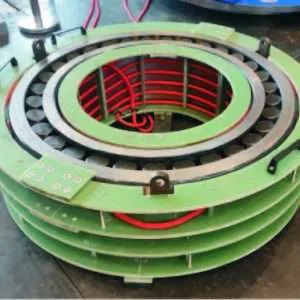-
1/7
-
2/7
-
3/7
-
4/7
-
5/7
-
6/7
Portable Induction Disassembly Heater
Portable Induction Disassembly Heater for Couplings, Stators, Rotors, Motors, Shafts, Wheels, Gears, etc: A Game-Changer in Industrial Maintenance
Industrial maintenance can be a challenging task, especially when it comes to disassembling parts that have been tightly coupled or assembled. Traditional methods of heating, such as gas torches, are not only time-consuming but also pose safety risks. This is where the portable induction disassembly heater comes in, offering a safer, faster, and more efficient solution.
What is a Portable Induction Disassembly Heater?
A portable induction disassembly heater is a device that uses electromagnetic induction to generate heat in metallic parts. It works by generating a high-frequency magnetic field that induces an electric current in the metallic part. The current, in turn, generates heat, causing the part to expand and loosen any tight connections.
Parameters Data:
| Items | Unit | Parameters Data | ||||||
| Output power | kW | 20 | 30 | 40 | 60 | 80 | 120 | 160 |
| Current | A | 30 | 40 | 60 | 90 | 120 | 180 | 240 |
| Input voltage/Frequency | V/Hz | 3phases,380/50-60 (It can be customized) | ||||||
| Supply voltage | V | 340-420 | ||||||
| Cross section area of power cable | mm² | ≥10 | ≥16 | ≥16 | ≥25 | ≥35 | ≥70 | ≥95 |
| Heating efficiency | % | ≥98 | ||||||
| Operating frequency range | KHz | 5-30 | ||||||
| Thickness of insulation cotton | mm | 20-25 | ||||||
| Inductance | uH | 260-300 | 200-240 | 180-220 | 165-200 | 145-180 | 120-145 | 100-120 |
| Cross section area of heating wire | mm² | ≥25 | ≥35 | ≥35 | ≥40 | ≥50 | ≥70 | ≥95 |
| Dimensions | mm | 520*430*900 | 520*430*900 | 600*410*1200 | ||||
| Power adjustment range | % | 10-100 | ||||||
| Cooling method | Air cooled / Water cooled | |||||||
| Weight | Kg | 35 | 40 | 53 | 58 | 63 | 65 | 75 |
The Benefits of Using a Portable Induction Disassembly Heater
1. Safety: The use of gas torches and other traditional heating methods poses a significant safety risk, especially when working in confined spaces. Portable induction disassembly heaters eliminate the need for open flames, reducing the risk of fire and explosion.
2. Efficiency: Traditional heating methods can be time-consuming and require a lot of energy. Portable induction disassembly heaters are more efficient, as they only heat the metallic part, reducing heat loss and energy consumption.
3. Precision: The high-frequency magnetic field generated by the portable induction disassembly heater can be precisely controlled, ensuring that the heat is applied only where it’s needed. This precision reduces the risk of damaging adjacent parts and ensures a clean and fast disassembly process.
4. Versatility: Portable induction disassembly heaters can be used on a wide range of metallic parts, including couplings, stators, rotors, motors, shafts, wheels, gears, and more. This versatility makes them a valuable tool in any industrial maintenance setting.
Applications of Portable Induction Disassembly Heaters
Portable induction disassembly heaters have numerous applications in industrial maintenance. They are commonly used for:
1. Disassembling couplings: Couplings are commonly used to connect shafts, and they can be challenging to disassemble. Portable induction disassembly heaters make the process faster and more efficient.
2. Disassembling stators and rotors: Stators and rotors are critical components in electric motors, and they can be challenging to disassemble. Portable induction disassembly heaters make the process easier and faster, reducing downtime and maintenance costs.
3. Disassembling gears and wheels: Gears and wheels are essential components in machinery, and they can be challenging to disassemble due to their tight connections. Portable induction disassembly heaters make the process faster and more efficient, reducing maintenance costs.
Conclusion
Portable induction disassembly heaters are a game-changer in industrial maintenance. They offer a safe, efficient, and precise solution for disassembling metallic parts, making maintenance tasks faster and more cost-effective. With their versatility and numerous applications, they are a valuable tool in any industrial maintenance setting.













